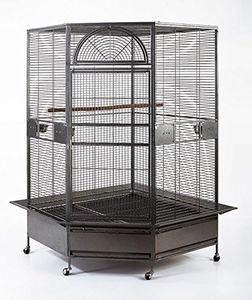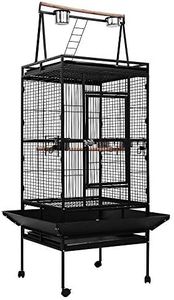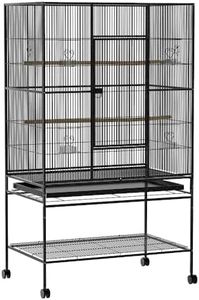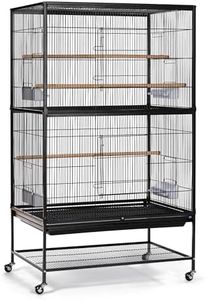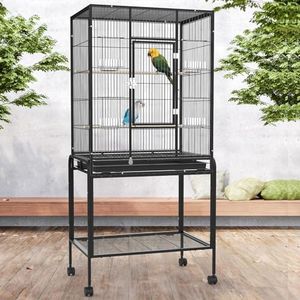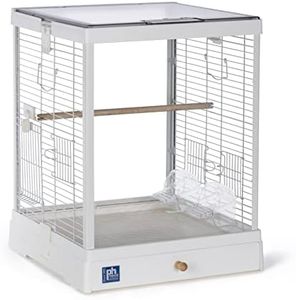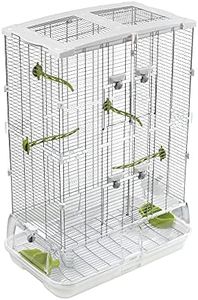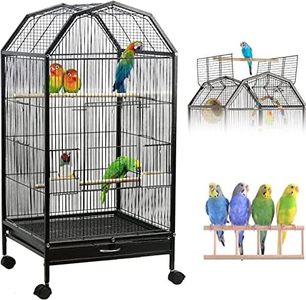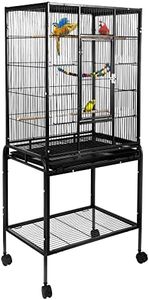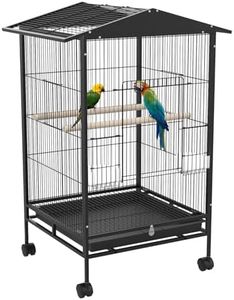We Use CookiesWe use cookies to enhance the security, performance,
functionality and for analytical and promotional activities. By continuing to browse this site you
are agreeing to our privacy policy
10 Best Parakeet Cages
From leading brands and best sellers available on the web.Buying Guide for the Best Parakeet Cages
Choosing the right cage for your parakeet is crucial for ensuring their health, happiness, and well-being. A good cage provides enough space for your bird to move, play, and exercise, while also being safe and comfortable. When selecting a parakeet cage, focus on factors that impact ease of use, durability, and your bird's safety. By understanding the key specifications, you can confidently pick a cage that matches your parakeet's needs and your home environment.Cage SizeCage size refers to the overall dimensions and internal space available for your parakeet. This is important because birds need ample space to fly and move freely to stay healthy and happy. Small cages can restrict your bird's movement, leading to stress and health issues. Generally, parakeet cages range from compact, travel-friendly sizes to large, spacious enclosures suitable for multiple birds. For a single parakeet, a cage at least 18x18x18 inches is considered a minimum, though larger is always better. If you have multiple parakeets or want to give your bird plenty of room to play, opt for a bigger cage. Think about the available space in your home and remember, your bird’s comfort should take priority when deciding on cage size.
Bar SpacingBar spacing is the distance between each of the cage’s bars. This matters for safety because if the bars are too far apart, your parakeet could squeeze its head through and get stuck or even escape. On the other hand, bars that are too close together can make the cage feel confining and may compromise airflow and visibility. For parakeets, ideal bar spacing is usually around 1/2 inch or less. When deciding, always measure to confirm that your parakeet cannot fit its head between the bars; if you have a smaller parakeet, aim for the smallest safe spacing.
Bar OrientationBar orientation means whether the bars are mostly horizontal or vertical. Parakeets enjoy climbing, so horizontal bars on at least two sides of the cage offer them better grip and exercise opportunities. Vertical bars make climbing harder and are less engaging for parakeets. When choosing a cage, look for one with some horizontal bars if you want to encourage active play and climbing, especially if your bird is particularly energetic.
Ease of CleaningEase of cleaning is about how simple it is to keep the cage sanitary and free from messes. A clean cage is vital to prevent illness and maintain a pleasant atmosphere. Cages with removable trays and wide doors are easier to maintain. Some cages feature slide-out bottoms or grates, which let you quickly remove droppings and old food. When picking, think about how often you’ll want to clean and whether the design helps make this task fast and convenient.
Material and DurabilityThe cage material affects both safety and longevity. Most parakeet cages are made from metal (often powder-coated or stainless steel) with some plastic parts. Metal cages resist chewing and are sturdy, but avoid any with peeling paint or rust because that can be harmful. Plastic cages are lighter but can be chewed through. If your bird is a strong chewer or if you want a longer-lasting cage, metal options are best. Always make sure the materials used are non-toxic and easy to wipe clean.
Doors and Access PointsDoors and access points are the openings used for reaching into the cage, cleaning, or interacting with your parakeet. Larger doors make it easier to place toys, change food and water, and handle your bird. Multiple doors can be handy, especially if you have more than one bird or want to add accessories. Look for secure locks that your bird cannot open easily, and consider how easy it is for you to reach every part of the cage.
Included AccessoriesMany cages include features like perches, feeding cups, or toys. These accessories save you from buying additional items immediately but vary in quality. Some cages come with basic, functional accessories, while others are more elaborate. Consider if the included items meet your parakeet’s needs for comfort and stimulation, or if you might want to add or upgrade these parts yourself.
Mobility and PlacementMobility and placement considerations involve whether the cage is easy to move, especially if it comes with wheels or a stand, and how well it fits into your living space. Some cages are light, portable, or designed as tabletop models, while others are heavier and meant to stay put. If you plan to move the cage regularly or take your parakeet to different rooms, choose one with smooth-rolling wheels and a stable base. If it will stay in one spot, focus on stability and how well the cage fits into your chosen area.
